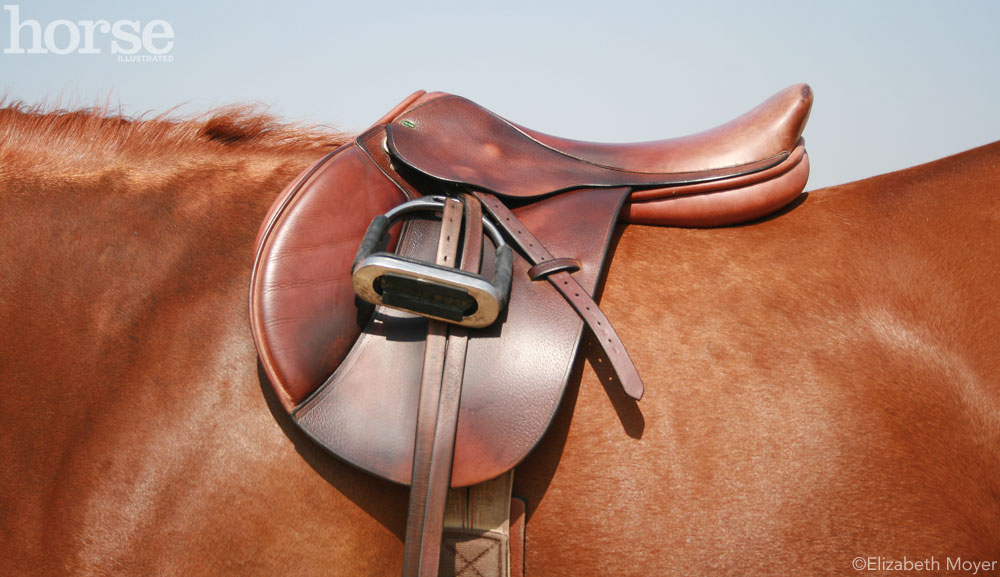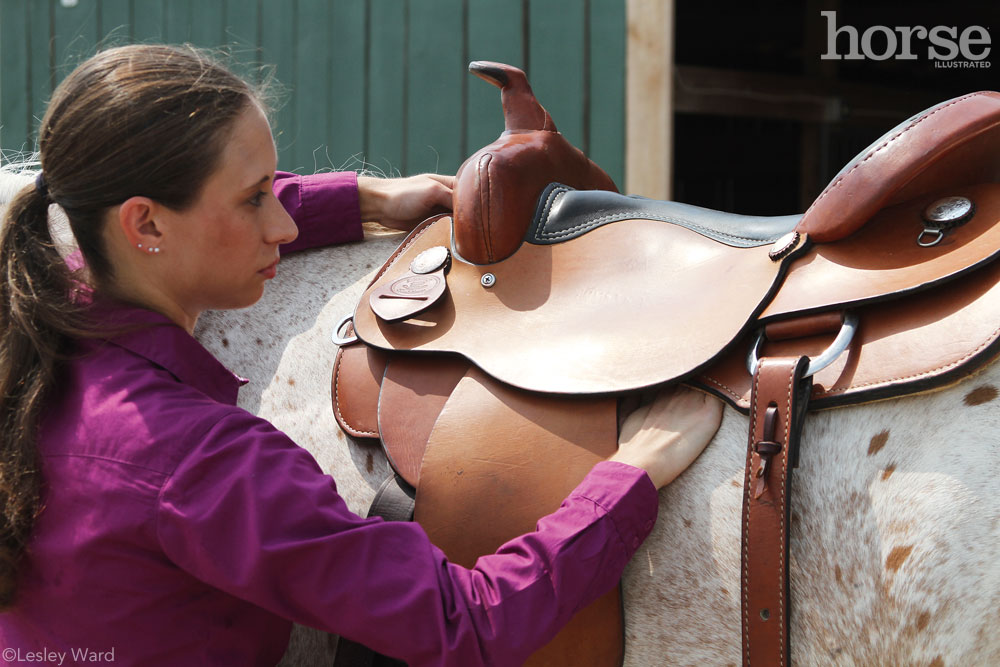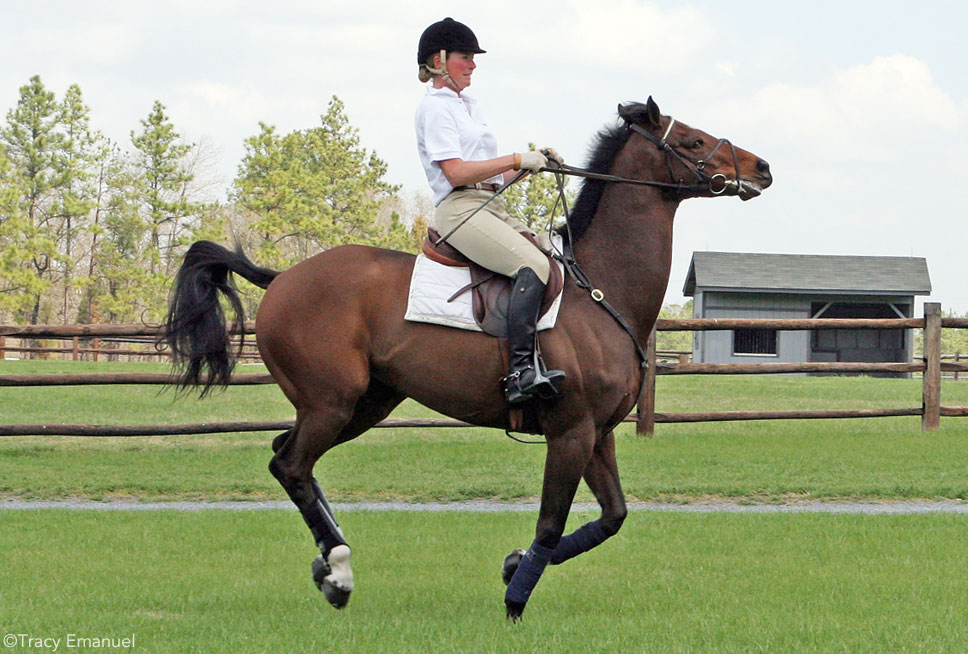
Spicy Little Number is a chestnut Thoroughbred gelding whose owner enjoys trail riding, as well as occasional dressage
and jumping. Although he’s usually happy and easy to get along with, on a recent long trail ride, Spicy got very fidgety and bucked his rider off. His owner admitted that the bucking episodes had happened before, especially when jumping. Rather than blame the horse, she thought it might have something to do with her being off balance and leaning too far forward, something she was working to correct in her riding lessons.

Simplify is a bay Quarter Horse gelding whose rider primarily uses him for trail riding and, on occasion, some trail class competitions. Over a period of months, Simplify started showing signs of grumpiness on long trail rides, especially when he had to go downhill.
This gelding is very short-backed and built so that his rump is higher than his withers—the classic “downhill” conformation. He also has somewhat of a swayback. Although his western saddle was comfortable for his rider, it was actually too long for Simplify’s short back, and the shape of the tree was too straight. As a result, the saddle was “bridging” over his back where it should have made contact, putting all the rider’s weight on his loin and the back of his shoulders. The more sore his back got, the grumpier he became.
Acupuncture and chiropractic treatments helped, but what really solved the problem was finding a saddle that had a shorter tree with the correct curves and angles so that it fit comfortably on his back.
The cases of Spicy and Simplify are just two of many in which improper saddle fit was causing serious problems. The good news for these horses is that their riders realized something was wrong and sought expert advice. Unfortunately for plenty of other horses, their owners get frustrated and switch to a stronger bit or other equipment in order to “make the horse behave.” They may even end up selling the horse because he eventually becomes unpleasant—or dangerous—to ride.
“Bad behavior is the most common problem I see as a result of improper saddle fit,” says saddle fit expert Joyce Harman, DVM, a veterinarian since 1984 and a certified veterinary acupuncturist whose Harmany Equine Clinic is located in Virginia. “It’s a sad thing, but a lot of people have a really nice horse that was an appropriate horse for them when they bought him. The horse then gets grumpy or nasty, and they feel they have to sell him because his behavior gets worse as time goes by.”
Harman has written books on saddle fit for English and western horses (The Horse’s Pain Free Back and Saddle Fit Book and The Western Horse’s Pain Free Back and Saddle Fit Book, both from Trafalgar Square Publishing). She was the first veterinarian in the country to use a computerized saddle-fitting device that produces a color scan of pressure points under the saddle while the horse is being ridden.
As we saw in the case of Spicy, a saddle that doesn’t fit the horse can also hamper the rider’s ability.
An ill-fitting saddle often puts the rider out of balance, notes Harman. “As humans, we are always going to go where gravity sends us, so if a saddle is too wide for the horse’s back, that saddle will pitch the rider down and forward. If the saddle is too narrow for the horse and sits too high in front, it will push the rider to the back of the saddle. This puts you behind your horse’s motion and puts your legs too far out in front of you.”
Price Doesn’t Guarantee Fit
After the horse, your saddle may be one of your greatest expenses. In many cases, the saddle can cost more than the horse! An expensive saddle that feels great to you doesn’t necessarily ensure proper fit for your horse.
“I’ve heard many riders say, ‘Well, my horse will just have to get used to this saddle,’” says Harman, adding that this is the wrong approach. “When the saddle fits both the rider and horse, it’s fun to ride, the horse is happy, and you feel safe. What I often see—particularly with saddles that are too wide—is that people start to feel unsafe. This is because the saddle makes them tip forward, affecting their balance.”
If you’re constantly struggling to stay in balance when you’re riding, this can indicate that the saddle doesn’t fit your horse.
“Tipping forward is very common in western saddles that don’t fit right,” Harman says. “People buy a Quarter Horse, so they get a saddle that has ‘Quarter Horse bars,’ which is a very wide fit. Many Quarter Horses today have more Thoroughbred in their bloodlines and are not wide across their topline.”
Because there are no industry-wide standards, saddle-tree sizes can vary, sometimes significantly, especially with English saddles. What one manufacturer may call “wide,” another saddle maker might call “medium.” The bottom line is that you want to find a saddle that matches the shape of your horse’s back as closely as possible.
With the prevalence of Internet tack sales, many people buy saddles online without ever trying them on their horse.
“This is a very risky idea unless there is a return policy,” Harman cautions. “The problem with buying on the Internet is that it’s a great place for someone to sell a ‘bum’ saddle, one that is crooked or has a broken tree. You also have no idea of fit. Because a saddle is assembled by hand, you can ride in your friend’s saddle made by a specific manufacturer and buy a saddle on the Internet that looks just like it, but it’s not the same. What you see advertised may or may not be the product you’ve seen elsewhere, and it may not fit the same.”
You always want to buy a saddle from a seller who lets you return it if you try it on your horse and it doesn’t fit. A reputable seller will allow this, provided you do so within a specified time frame and there is no damage or wear to the saddle.
Padding the Issue
You can buy a fancy, high-tech saddle pad, but it won’t fix a poor-fitting saddle.
The pad is meant to provide cushion and comfort, but it should enhance the fit of the saddle, not try to correct equipment that doesn’t fit. Your choice of pad should be secondary to your choice of saddle.

“Changing pads can initially give the horse relief because you move the pressure point to a new location, but if you have a problem, it will find its way through the pad,” says Harman. “I call it the ‘princess and pea syndrome.’ It may take three weeks or it may take six months, but the problem will find its way through the pad and your horse will feel it the whole time.”
Basic Saddle Fit Requirements
So, how can you tell if that saddle you fancy actually fits your horse?
Ideally, you’ll have a saddle fit expert (find one in your area using an Internet search) come out in person to see the saddle on your horse and evaluate fit. If this is not possible, you should educate yourself and check key areas to determine fit.
First, let’s look at the basics of saddle construction. The saddle is built on a “tree,” and this is what determines whether or not the saddle will fit. If you could remove all the outer leather of the saddle, you’d find the framework of the tree. In a western saddle, the “bars” of the tree are the portions along each side that rest on the horse’s back. If those bars follow the contours of the back, they will make full contact all along the back. This gives optimal fit and comfort because it spreads out the weight-bearing area. Problems begin when the bars are not the same shape as the back, because this forces the rider’s weight into a smaller area.
Saddle Placement
Be careful that the saddle is in the right position on your horse’s back when you tack up. There should be a natural “pocket” just behind the shoulder, and this is where you want the saddle to rest. Putting the saddle too far forward or too far back can cause pain and inhibit the horse’s stride.
“The weight-bearing part of the horse’s back is from behind the shoulder blade to the last rib, so the weight-bearing portion of the saddle needs to fit this area,” explains Harman. “On a western saddle, the skirting can extend past these areas, but no part of the saddle that bears weight.”

How to Check Your Saddle Fit
- Place the saddle on your horse without a pad and tighten the girth. Does the saddle tip up in the front or the back? Either of these indicates poor fit. If the back of the saddle tips up, this usually means the saddle is too wide.
- Stand back and look at your horse from the side. Is the saddle too long for his back? If so, this places excess weight on the withers and the loin area.
- Slide your hand under the saddle palm down, so that your hand is under the tree bar (western saddle) or the middle of the panel (English saddle). Starting from the front, slowly move your hand backward to the end of the saddle. Notice if there is any change in pressure on the top of your hand; it should remain the same. If you don’t feel pressure on top of your hand in the middle of the saddle, this indicates the saddle is bridging the back, which is going to result in pressure points at the front and back, definitely something you don’t want.
- With your hand under the saddle, locate your horse’s last rib, which is at the end of the rib area before the softer loin region. Is there pressure from the saddle tree behind this rib? That’s a no-no. It’s OK if the skirting on a western saddle extends to this area, but you shouldn’t have pressure from any part of the saddle itself.
- Now, mount up. Under no circumstances should the saddle make contact with the horse’s spine, particularly the withers.
“You’ll hear some people say you need three fingers’ space between the saddle and withers, but this is a fallacy,” says Harman. “With a high-withered horse, you might only have room for two fingers, and with a low-withered horse, you might be able to fit five fingers between the saddle and withers. The key is that there should be no contact between the saddle and the withers when the rider is in the saddle.” - Finally, if you think the saddle fits well, put your pad in place and check again to see if you notice anything different.
Even if your saddle is currently a good fit, be aware that your horse’s back will change through the years, and if he gains or loses weight and muscle. The smart rider will keep in mind the importance of saddle fit and evaluate it on a regular basis.

A change in behavior under saddle could be indicative of a poorly fitting saddle.
Signs of Poor Saddle Fit
- Objection to being saddled
- Sensitivity to being brushed or touched in the back area
- Tail swishing
- A change in behavior when ridden, including bucking or acting up
- Pinning the ears
- Tossing the head
- Slow to warm up or relax
- Reluctance or refusal to change leads
- Lack of extension
- Excessive concussion or choppy movement
- Inability to use the back and hindquarters properly
- Muscle atrophy or lack of development, despite exercise
- Uneven hoof wear
- Hard-to-diagnose lameness problems
One final note: The right saddle fit won’t make your horse more athletic, but the wrong fit can negatively impact performance and attitude. You and your horse will have the best opportunity for success and safe riding when you choose a saddle that fits him well.
Cynthia McFarland is an Ocala, Florida-based freelance writer and horse owner. The author of eight books, her latest is Cow-Horse Confidence: A Time-Honored Approach to Stockmanship, co-authored with Martin Black.
This article originally appeared in the 2015 edition of Your New Horse.





